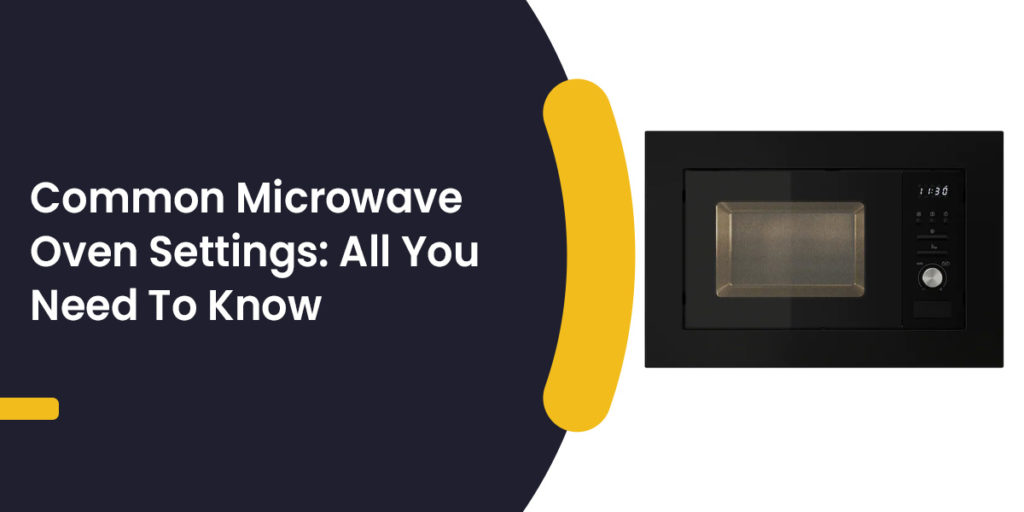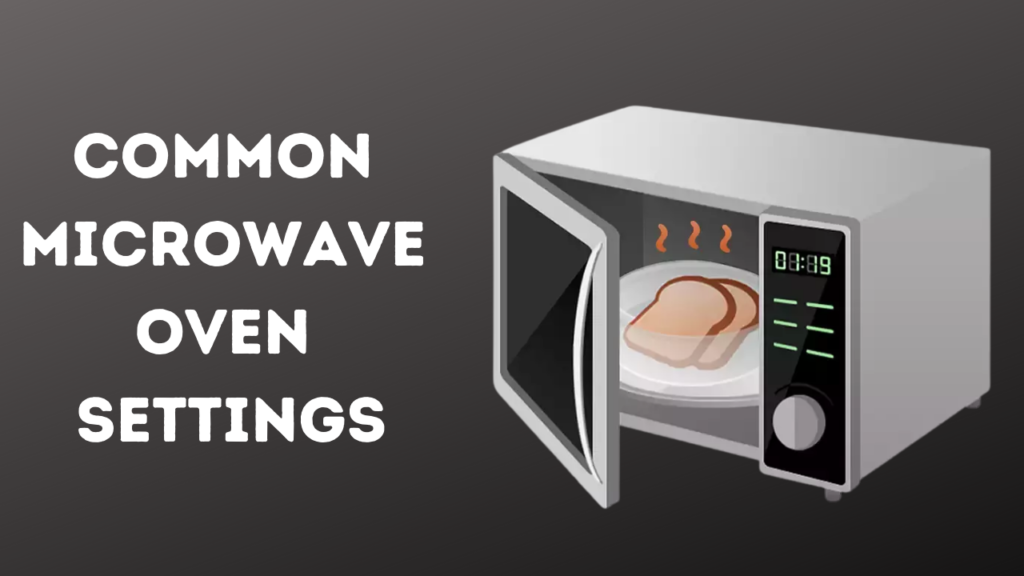Contents

Looking for common microwave oven settings? Read to know more.
If you are new to microwave ovens, all the settings you see on one might make you confused. It wouldn’t be the first person I heard that from.
When I tell you about the microwave oven settings, you’ll be able to start making great dishes. You will be using your oven like a chef once you have read everything I have. Without further ado, let’s get to it.
What is a Microwave Oven?
The microwave oven has revolutionized modern homes. It’s designed to quickly heat food by using special electromagnetic radiation, and it’s designed and primarily used to quickly heat food.
Unlike traditional ovens, it cooks food from the inside rather than from the outside. While it was originally used in commercial kitchens, it’s now used in homes and the workplace.
Most Common Microwave Oven Settings
Power Level
This is one of the least complex settings. You can set power levels from 100 Watts to 1000 Watts using power level buttons. Most ovens are able to operate at 5 levels of power. They are, that’s right.
Very Low
This is one of the least complex settings. You can set power levels from 100 Watts to 1000 Watts using power level buttons. Most ovens are able to operate at 5 levels of power. They are, that’s right.
Low
When this setting is on, the oven usually runs around 100 to 400 Watts. It is the most useful for making stuff softer. It is possible to melt food like cheese or butter.
Medium
A good setting for baking is this one. Around 400-500 Watts is what it usually is. It can also be used to make meat more tender.
High-Medium
The setting is over 800 Watts. It is good for baking or cooking.
High
This option has the highest power level of 800 to 1000 Watts. You can use it to cook food with a lot of water in it.
Timer Setting
The power level setting is important, but the timer setting is equally important. It can be set to as little as one second and as long as 99 minutes and 99 seconds. If you want to set the time, just press the “Set Timer” button, hit the input your recipe needs, and then press start.
Once the timer has finished, you will receive a notification with a distinct sound. If you change your mind midway through cooking, there is a “cancel timer” button that you can use.
Start
It does what the name says it will do. When you press the button, the oven starts. Remember to set the power level and timer before the event.
Stop
Even if the cooking process is already underway, this button stops the oven from working. It also clears the timer and power level values, though some rare ovens come with a “Clear” button that needs to be pressed separately to do that.
Defrost Setting
You can quickly thaw frozen food through microwaves with this setting. Most ovens these days have defrosted settings on them. Depending on the model, the amount of input you need to put in is different. The majority of people can automatically adjust their settings once the button is pressed, though a few will ask for time or power level.
Microwave Setting
The setting is supposed to be used for boiling vegetables. It works well for people who don’t need a lot of water for cooking. Even after the microwaving is complete, this setting doesn’t get rid of any of the vitamins and minerals contained in the food.
Convection Or Fan Setting
You won’t see this setting in the regular ovens. Fans that are equipped with the oven ensure that food is brown and crisp. It is a great place to bake for anyone that likes it.
Steam Setting
It’s called the name, and it says it all. It is a great setting for steaming food. Thanks to the little amount of water these items usually contain, it works well with meat and vegetables.
Grill Setting
If you happen to be a fan of grilled food, you will fall in love with this option. You will almost turn your oven into a grilling machine. When using this setting, keep in mind that the thicker the item is, the more likeliness there is of uncooked spots inside it.
Convection Grill Option
It’s another special perk of owning a convection oven. Since microwaves also have a grill feature, this option combines the two features to ensure that your grilled food gets charred from both sides.
Upper Heating Option
Most of the heat in the oven is focused on the upper part of the interior when you use Upper heating. The cooking of cakes requires the top to be cooked more than the bottom, so this kind of heating is great for that.
Lower Heating Option
This heating type focuses most of its heat on the lower part of the oven interior, which ensures that everything from the bottom gets cooked properly and evenly. Since the dough needs to be cooked properly for better taste, it is useful for making pizza.
Child Lock
This setting is not available in all ovens, but it is an incredibly handy one. If you have little kids with a habit of messing with the oven settings, turning it on will lock the control panel so any further adjustments don’t work. They can’t unlock the panel on their own because it doesn’t have a switch. It can only be turned on and off with the help of a specific button combination.
How a Microwave Oven Works
A microwave oven works by using microwaves to heat food. Microwave ovens are most effective at heating up food and beverages because they operate at a very specific frequency and wavelengths.
The reason for this is that water molecules have a natural tendency to vibrate at a certain frequency, which is why the water in milkshakes gets hot when you shake them up in a blender. When it comes to food in the microwave, rotating a plate is a useful way to make sure that food cooks evenly.
Microwave ovens were accidentally invented in 1946 by Dr. Percy LeBaron Spencer, who was working on magnetron vacuum tubes at the Raytheon Corporation.
While working on magnetron vacuum tubes, he found that he could heat his candy bar by walking by a vacuum tube and that popcorn kernels popped in the same location.
He realized that microwaves from the vacuum tube could heat food and experimented by putting popcorn kernels in the same location.
Raytheon then bought Amana Corporation in 1965, which then released a counter-top Radarange microwave oven in 1967 for $600, which still made it quite expensive for households. Microwave ovens were initially found the most popular in Japan.
By 1975 Americans were comfortable with microwave ovens. By 1976 Americans were outselling gas ranges, and by 1976 Americans had become the number one market for microwave ovens, with 52 million U.S. homes having a microwave.
Different Types of Microwave Ovens
The counter-top microwave oven was the first to reach the market. Since then, over-the-range (OTR) microwaves and cabinet-mounted microwave ovens have also entered the market.
Counter-top microwaves are the cheapest and most mobile; while they take up precious counter space, the advantage is that they can be taken from one house to another, if necessary. OTR and cabinet-mounted microwave ovens save counter space, but they are more
costly, immobile, and may need to be installed by a professional. Convection microwave ovens have heating elements and fans which cook the food in external heat, which cooks the food from the outside as well as the inside.
Energy Efficiency
Energy usage rates by microwave ovens typically range between 750 and 1100 watts. This is higher than a refrigerator but lower than a clothes iron.
The kilowatt-hour per unit usage ranks at about 200 kWh, which is more than a color TV but less than an electric oven. To bring a cup of water to a boil, a microwave oven uses 25 % more energy than an electric stove.
However, this difference amounts to less than a dollar of energy usage per year. Re-heating food in the microwave, on the other hand, uses 80 % less energy than reheating in a conventional oven.
This confirms the perception that one of the microwave’s primary benefits is re-heating food or cooking smaller portions.
Benefits of Using a Microwave Oven
When it comes to making a healthy breakfast, the benefits of using a microwave oven outweigh the disadvantages. A microwave cooks food faster than a conventional oven, and it also retains some of the vitamins that are lost when food is cooked in a regular oven.
Microwaves don’t brown food either, so you get the same results as if you’d cooked it on an unventilated stove. There are many dangerous organisms that have less time to grow and reproduce on foods that are microwaved.
They don’t get enough time to grow because they’re taken to a higher temperature than usual and it takes a little time for them to cool down before they can reproduce.
Safety Features
In compliance with FDA regulations, most modern microwave ovens have redundant safety systems that will stop the microwaving process once the door is opened. They can also detect when steam or temperature levels are high and will shut off cooking when the oven reaches a certain temperature.
Microwaves also must meet a federal requirement that says they cannot emit more than 5 milliwatts of radiation beyond 2 inches from the oven; this prevents any potential damage that could be done to pacemakers.
Effects on Food and Nutrients

Microwave ovens can reduce the amount of vitamins B, B1, C, and E in foods. Microwave ovens can also damage the protein and amino acid contents in meats and reduce the food’s nutritional value.
However, it is often better than boiling the same foods, which will remove even more of these nutrients because nutrients are lost through prolonged exposure to heat. It is recommended not to use microwave ovens to warm up bottled breast milk because it can reduce its nutritional value; it is advised to heat up breast milk under hot water instead.
Microwave Hazards
Microwaves are as dangerous to your health as they are useful. Studies show that microwaving certain foods may cause the creation or accumulation of acrylamide, a cancer-causing chemical.
Another known hazard with microwaves is the danger of metallic objects sparking inside the oven cavity, which can lead to damage to the oven. Water can be heated using a microwave oven up to the point where it will explode and burn. Water should never be heated in a microwave oven with a smooth, scratch-free container because heating can cause damage to the oven and the container.
FAQ’s – Common Microwave Oven Settings
What are the disadvantages of a convection microwave oven?
Not all microwaves are created equal. While all microwaves have the same basic capabilities, there are some important differences between microwaves.
A convection microwave has a fan that circulates hot air around the food, which allows for more efficient cooking and browning, making it a good choice if you often cook food that is highly browned at the edges.
How to choose the right convection microwave oven for my kitchen?
If you want to get the best out of your microwave, ensure that your electrical wires are up to the job, that you have a reliable power source and that you have an inner wall that is coated with an appropriate material.
Coated walls are usually found in low-end models but are easy to clean. Stainless steel is usually more durable and less susceptible to staining but it can be easily scratched.
